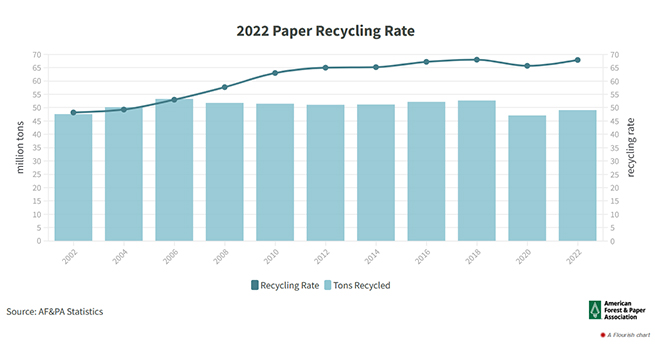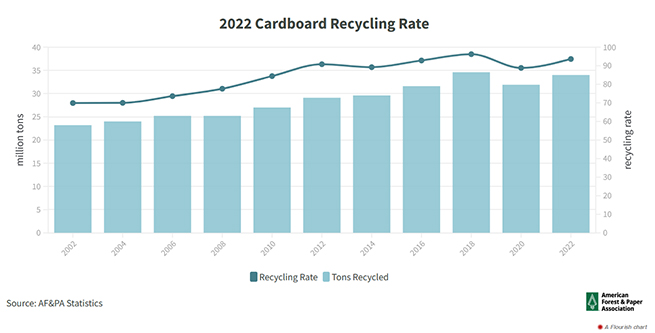Paper recycling is an environmental success story. More than two-thirds of the paper used in the U.S. is recycled and used to make new sustainable paper products people use every day. That’s more than 50 million tons of paper.
To unpack the paper and cardboard recycling rates further, we turned to AF&PA’s Executive Director of Recovered Fiber Brian Hawkinson to answer a few commonly asked questions.
How much paper is recycled in the U.S.?
Nearly 68% of all paper consumed in the United States was recycled in 2022. The recycling rate has more than doubled since 1990, and the U.S. paper recycling rate has met or exceeded 63% since 2009. In fact, more paper is recycled by weight from municipal waste streams than plastic, glass, steel and aluminum combined.
This is due largely to the industry’s efforts to:
- Produce more sustainable paper products.
- Invest in recycling infrastructure.
- Increase the availability of community recycling.
- Educate people about the best ways to recycle paper and paper packaging products.

How is the paper recycling rate calculated?
The recycling rate is calculated using AF&PA data on the amount of recovered paper used to make new paper and paperboard by U.S. paper mills and U.S. Census Bureau data on net exports of recovered paper and comparing that total to the new supply of paper and paperboard in the U.S. over the same time period.
The rate informs how much paper is diverted from landfills. It is an important indicator of how much recovered paper is used to make new products.
What are old corrugated containers?
Old corrugated containers, also known as OCC, are used cardboard materials. Old corrugated containers include everything from cardboard shipping boxes to pizza boxes. Cardboard is the most recycled packaging material in the U.S.
More than 93% of OCC was recycled in 2022 – and increase from 2021, and overall, a three-year average of 91.3%.
AF&PA has published the annual U.S. OCC recycling rate since the introduction of the Corrugated Recycles symbol in 1993. The rate has followed a steady trend upward from 54% in 1993 to the current rate of 93.6%. The cardboard recycling rate has met or exceeded 82% since 2009.

How is the OCC recycling rate calculated?
The U.S. OCC recycling rate is calculated similarly to the paper recycling rate. It divides the U.S. recovery of OCC for recycling by the U.S. supply of containerboard (the material used to make corrugated boxes that has not yet been converted into boxes) over a given period, usually one year.
A Bloomberg Intelligence/Circular Ventures, LLC estimate concludes that the OCC recycling rate is around 69%. Why are these numbers different?
AF&PA is driven by fact-based public policy and marketplace advocacy. AF&PA’s OCC recycling rate calculation is consistent with the method used by major U.S. trading partners around the world, including the European Union and Japan, and is similar to the recycling rate published by the U.S. Environmental Protection Agency.
The Bloomberg Intelligence/Circular Ventures, LLC estimate uses a different methodology and does not account for boxes used to export products from the United States. It also requires assumptions about imports of packaged products. It is imperative for the industry to use accurate and complete data.
Can I recycle my paper products at home?
AF&PA’s 2021 Access to Recycling Study found 94% of Americans have access to a community paper recycling program. And 79% of Americans have access to residential curbside recycling programs for paper and paperboard. That’s an increase of about 14 million people since 2014, the last time AF&PA conducted its study.
Many paper products used every day across the U.S. have a high community access rate of 80% or more. Meaning things like cardboard boxes, newspapers, paper bags, pizza boxes and magazines are widely accepted for recycling.
The American Forest & Paper Association (AF&PA) serves to advance U.S. paper and wood products manufacturers through fact-based public policy and marketplace advocacy. The forest products industry is circular by nature. AF&PA member companies make essential products from renewable and recyclable resources, generate renewable bioenergy and are committed to continuous improvement through the industry’s sustainability initiative —Better Practices, Better Planet 2030: Sustainable Products for a Sustainable Future. The forest products industry accounts for approximately 5% of the total U.S. manufacturing GDP, manufactures about $350 billion in products annually and employs about 925,000 people. The industry meets a payroll of about $65 billion annually and is among the top 10 manufacturing sector employers in 43 states. Visit AF&PA online at afandpa.org or follow us on Twitter @ForestandPaper.
Source: AF&PA













